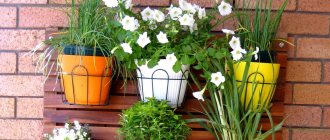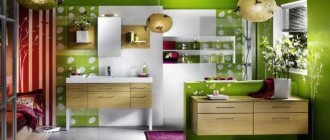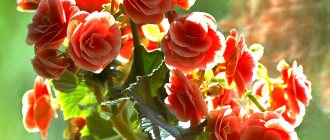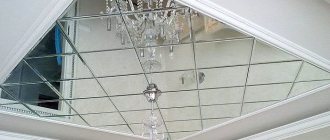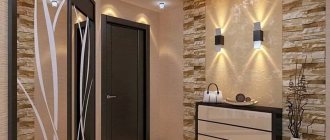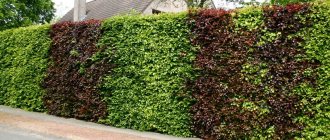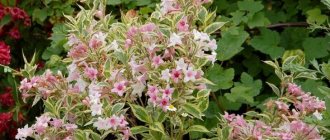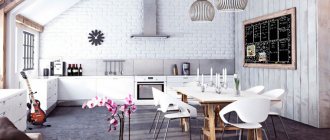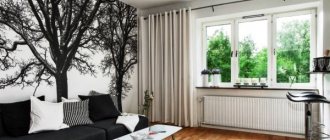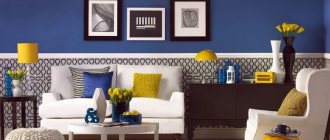2018 broke the scale of fashion interior values. Now - suddenly! – it is announced that a house without greenery is a thing of the past, that it is old and inexpressive. Suddenly it turned out that interior design without plants looks unfinished and faceless.
It lacks the fireworks of colors, grooming, originality, it looks bare and uninhabited. Everything can be learned by comparison: indeed, several living green plants in the interior of an apartment so transform the appearance of the room that if you remove them, a vacuum will form that cannot be filled even with very beautiful things.
Indoor plants transform the interior
This news inspired some to go to flower shops, others plunged into panic - after all, there are people in whose hands even a cactus will wither. Let us reassure you right away: there are acceptable design options for everyone; as a last resort, you can buy artificial plants for the interior.
But where to start? Certainly not from buying flowers!
Until then you will have to:
- find out whether vegetation in the house is useful;
- determine which corners of the apartment lack green areas and what role they can play in zoning and visual transformation of space;
Indoor plants can participate in room zoning
- figure out whether it is possible to combine the beautiful with the useful - with the edible, for example;
- decide in what frame the living accessories will appear - get acquainted with the types of pots, cache-pots, shelves, jardinieres, florariums;
- recover from the shock of discovering what unusual interior landscaping options designers have come up with (oh, believe me, they have nothing to do with geraniums on the window);
Consider unusual landscaping options
- breathe a sigh of relief upon learning about the existence of closed automated life support systems for plants in the interior;
- grab your heart (or wallet) by finding out how much such systems cost;
- assess the degree of illumination, humidity, temperature;
- develop a project for placing plants in the interior of the house;
- and only after that, choose the plants themselves for the interior - with the help of a designer or flower seller, taking into account the architectural style and your own inclination (or not inclination) towards floriculture.
Indoor plants should be in harmony with the interior style
It is reassuring that there is a grain of humor in such a serious algorithm. In the end, even randomly found flowers, geranium or ficus, will add the forgotten sweetness of good old traditions to the design and will be regarded by aesthetes as a fashionable touch. But we want more?
So, put aside your fears and go ahead and explore the green world of modern design!
Myths about houseplants
Superstitions regarding indoor flowers that ward off good luck are controversial, but arguing with them is a thankless task. Whether this is true or not, ivy has a bad reputation as a persecutor of men. It is believed that ivy prevents a lonely young lady from bringing a man into the house, and even more so from keeping him. At the same time, in narrow circles of magicians and fortune tellers, they note the ability of ivy to extinguish emissions of energy - both good and bad. Conclusion: after a scandalous breakup with a lover, ivy is just the pill that will help you forget, forgive and calm down.
There is talk about ivy's ability to dampen energy releases - both good and bad.
By the way, after ivy, its specific properties began to be attributed to other climbing plants in a residential building. It’s somehow a pity to abandon such a decorative category of indoor flowers because of unsubstantiated accusations, especially since ivy is clearly in trend.
The orchid suffers for almost no reason - it has been attributed to a suffocating effect due to the mere appearance of the roots, which supposedly entangle the sleeping person.
All the discussions about plants releasing carbon dioxide at night are pure truth. However, in the bedroom their presence is critical only if the room is hermetically sealed and not ventilated. To be honest, in such conditions it will be stuffy even without flowers.
Ventilate rooms with flowers
A more serious version seems to be that strong-smelling flowers interfere with night rest. Indeed, the intoxicating aroma can give you a headache during the day, although all this is very individual.
For allergy sufferers, any contact with pollen is undesirable; it is better for them to choose indoor flowers with decorative leaves. However, the soil also poses a danger, spreading fungal spores. This does not mean that you will have to give up your home greenhouse: you can, for example, cultivate green lawns using a hydroponic artificial irrigation system or use artificial flowers that skillfully imitate natural ones.
Plants in a hydroponic system are suitable for allergy sufferers
Conditionally poisonous plants pose a real serious threat and should be used with great caution. Poisonous greens include: aglaonema, anthurium, alocasia, croton, monstera, spurge, oleander, pachypodium, fatsia, dieffenbachia - their photos must be carefully studied and remembered.
Surprisingly, almost all of them turned out to be designers' favorites in 2018 - these plants are so picturesque! Shouldn't we give up such beauty? As a last resort, they can be placed in the upper tier of landscaping - it’s safer.
Picturesque monstera in the interior
It remains to add that, with very rare exceptions, plants in the interior of a residential building play the role of an island of nature, which refreshes and moisturizes the air, soothes, and pleases the eye.
Plants in the bedroom
Outdoor plants in stylish flowerpots fit harmoniously into the spacious bedrooms. Miniature roses or violets are suitable for rooms in country or Provence style. It is not advisable to overload the bedroom with an abundance of flowers, especially those with a strong scent. It is better to avoid lilies and ferns, as they “steal” oxygen.
A trend in bedroom landscaping is to grow essential greens. You can fill the room with a pleasant aroma by planting myrtle, mint, tea tree or oleander. Lavender will help overcome stress and insomnia.
Room design with flowers
Decorating a room with flowers
See alsoDecorating a vase: a highlight in the interior
The triumphant return of the ficus - new botany in the interior
How did it happen that in 2021 designers turned to indoor plants? This became a logical continuation of the idea of ecological phytodesign of the interior, which the Japanese and Scandinavians have never changed. The need for natural materials, natural forms and islands of nature inevitably resulted in an interest in house plants and the search for their new role in home decoration.
The revolutionary direction was called “new botany”. It has penetrated into the interior of all existing styles, from urban to country, from minimalism to classic.
The mission of indoor plants is to harmonize the design of the home and bring a new melody to it.
Indoor plants will bring a fresh note to the interior
How necessary are indoor plants in the interior of an apartment decorated in a certain style, and which ones should you give preference to?
Plants in the interior of the hallway
Beautiful plants and flowers in the hall are an indicator of a reverent attitude towards the house. A spacious and well-lit hallway provides endless possibilities for phytodesign. Large plants in massive pots look great in a large space. Ficus trees with their huge glossy leaves will be the final touch to decorating a retro-style hallway. Plants such as dracaena, bottle tree, yucca or ficus benjamina are suitable for classic and modern interiors. A modern hallway can be decorated with figuratively trimmed boxwood or all kinds of palm trees.
Plants in the interior of the hallway
Don't despair if the hall is small or dark. It can be decorated with a composition of unpretentious potted flowers or shade-loving specimens. The most suitable options: aspidistra (a small plant with attractive large leaves), sansevieria (a compact plant with leaves tightly pressed together) and asplenium (a representative of ferns). If there are niches in the hallway, place low-growing bonsai-style trees in them.
Decorative plants in the hallway
Ordinary ivy looks very unusual in the hall. It can be placed on a high shelf, with descending shoots entwined around a mirror or photo frames.
Indoor ivy in the hallway interior
The main thing is not to forget to periodically expose the plants to the sun, otherwise even the most unpretentious options will quickly die.
Fashionable aesthetics of the concrete jungle - a combination of loft and living plants
What does ficus do in a loft interior? No, he's not blocking a hole in the wall!
A large plant in an urban interior plays the same role as a red leather sofa or a painting in a gilded frame - working “in contrast”, it emphasizes the picturesque imperfections of industrial textures.
Well-groomed greenery against a background of concrete or brickwork enhances the shocking effect. For loft apartments, voluminous plants with expressive large leaves are selected, in stone tubs or metal containers adapted for them (photo).
Plants with large leaves are suitable for loft apartments
A daring technique for landscaping a loft is an imitation of an industrial greenhouse. Industrial lattice glazing, irrigation pipes and lush greenery in an enclosed space develop style ideas in an unexpected way.
Plants in flasks, transparent balls, in glass jars - these fashionable florariums seem to be created to create local green accents in an urban interior.
Florariums are ideal for loft-style interiors
Indoor plants and flowers in the kitchen interior
The first thing you need to pay attention to is the place where the pots will be located. There are several kitchen areas where indoor plants simply won’t do well:
- The sink area is dangerous for flowers not so much due to excessive humidity as the presence of household chemicals near it. Even eco-friendly products can cause irreparable harm to plants. This is especially true for the greens themselves, which many cleaning products simply corrode;
- Area near the stove - in addition to constant temperature changes, indoor plants will suffer from excessive heat, which will scorch the foliage and dry out the soil and root system. If the hood is constantly running above the stove, it will absorb all the oxygen;
- The area on the refrigerator - if you remember the laws of physics, you can understand that all the hot air from the kitchen will accumulate under the ceiling. This will cause the flowers placed there to wither within a few days.
- If the interior design includes a living wall of wild grapes, the condition of the soil should be monitored daily, and the upper leaves should be constantly moistened with a spray bottle.
If the kitchen windows do not face south and the plants are not exposed to direct sunlight for a long time, you can place a ficus pot on the windowsill.
This plant is extremely unpretentious to the conditions, does not require frequent watering, and the deep emerald shade can advantageously highlight the design elements of the room.
Plants such as begonia, aloe, and croton are perfect for bright kitchen areas. The latter will fit perfectly in a kitchen decorated in autumn shades.
For orchid lovers, the royal phalaenopsis is suitable - an unpretentious orchid that is characterized by long flowering. It perfectly withstands a lack of sunlight and temperature changes.
Ivy can be used in kitchen design if there are vertical guides that it can skillfully disguise. Ivy in the form of an ampel looks very original and unusual.
Begonia elatior blooms when most plants are dormant - in late autumn and winter. If you take care of the flower and regularly fertilize the soil, it will bloom all year round.
Saintpaulia (or Usambara violet) does not require regular watering, and the dried top layer of soil is beneficial for the plant. It is better to install it where there is a lot of daylight or artificial light.
- Usambara violet
- Spathiphyllum
- Begonia
Spathiphyllum loves warmth and moisture, so it will take root well in the kitchen. It is this indoor plant that is considered a symbol of family well-being.
Scindapus is suitable for spacious rooms, as it can grow by 70-80 cm in a year. It is used for vertical gardening in various rooms. The kitchen area is no exception, as the flower is resistant to high humidity.
If you want your kitchen interior to have flowering indoor plants, you should pay attention to wax ivy, Kalanchoe, hibiscus, hyancit and begonias.
Useful plants in the kitchen interior: seasonings at hand
For those who are seriously interested in cooking, it is worth paying attention to the modern trend of planting a variety of herbs and spices in small pots, which are easy to care for.
Freshly cut greens will immediately appear in the dish, bypassing the stage of drying, packaging and sale.
Most often, housewives plant plants such as mint, basil, green onions, oregano, rosemary, and dill.
Seedlings can be placed in small wooden boxes, wicker flower pots or small clay pots, highlighting the unique style of the kitchen.
Flowers and plants for kitchens without windows exist and fit well into any design, read the article about unpretentious species here
Warm to cold: indoor flowers in a high-tech interior
What might greenhouses look like on a space station? Probably the same as plants in high-tech apartment design projects.
First of all, these are lawns, horizontal and vertical. By the way, a vertical lawn is a complex engineering structure with an automatic watering system, which conceptually fully complies with the principles of high-tech style.
Vertical gardening for high-tech interiors
Florariums, miniature and voluminous, are semi-closed ecosystems with a microclimate. They are picturesque and perfectly harmonize with the glossy surfaces of the interior.
A vintage element – ceiling plants growing “upside down”. This is something that surprises immensely every day, something that is impossible to get used to. But it is in high-tech that such interior landscaping seems quite logical.
Creative plants growing upside down
Plants in the living room interior
Due to the fact that the living room is the largest room in the house, absolutely any plants can be placed here. Pots are placed according to the standard pattern: shade-loving ones - in the corners and away from windows, light-loving ones - closer to sources of natural light. Large plants are in trend now. Especially if they bear fruit.
Plants in the living room interior
The interior can be enlivened by olive and coffee trees, kumquats, lemon and orange trees, and even a banana, which can bloom for several months.
Large-leaf indoor plants in the interior
Large plants can fit into almost any design: in a classic style with heavy furniture and pretentious drapery, and in a high-tech or minimalist style. Pots and tubs decorated in the chosen style will help enhance the effect. Massive flowerpots are suitable for classics, while minimalism is characterized by laconic flowerpots with clear and even hard lines. Decorate your seating area by placing identical pots with identical plants on both sides of the sofa.
Indoor plants in the living room interior
Or create a unique composition by selecting pots from the same series, but of different sizes. You can use the technique of zoning space, because identical tubs with tall plants can replace a screen. Place them in a row to delimit functional areas.
Plants in the dining area
If the living room is small, it can be visually enlarged with the help of climbing plants that will fall from hanging plant pots or high shelves.
Plants in the interior of the work area
Be sure to provide the possibility of attaching young shoots, otherwise one day you risk getting an impenetrable jungle. To create a light and natural interior, use small compositions. Avoid bright, flashy colors. Plants with large and wide leaves look great in spacious living rooms.
Indoor plants are a wonderful decor for a spacious living room
Consider the fact that in plain pots, bright, colorful specimens look most attractive. Modern versions of flower pots and tubs are equipped with discreet wheels for easy movement of heavy plants.
Heroes of eco-design – all areas of country style
What did the fashion trend of “new botany” give to the country style, in which flowers and green plants were traditionally present? First of all, he raised the status of the country music genre. Secondly, the developments of the new wave gave interior designers fresh ideas and magnificent floral accessories - stands, whatnots, jardinieres, flowerpots.
It would be a slight exaggeration to say: there are so many country style trends. Let's consider techniques for using indoor flowers and plants in the interior of city apartments with rural design.
Flowers and scents of Provence
In the French provincial style of Provence, flowering crops are in the lead:
- roses;
- violets;
- geranium;
- oleander;
- bulbous - tulips, hyacinths, daffodils, crocuses;
- mini-lawns in pots made of cereals, lavender, herbs.
- as well as evergreen laurel, ficus, etc.
Violets will fit perfectly into a romantic interior in Provence style
The peculiarity of Provence is the adaptation of a variety of containers as flower pots and ingenuity in their handicraft decoration. They are painted, aged, covered with craquelure and patina.
An important element is the abundance of shelves, jardinieres, shelves and improvised pedestals for plants. In Provence, it is customary to place flower pots on the windowsill, on the kitchen sink or dining table.
In Provence, it is customary to place flower pots on the windowsill
American country
The least affected by new landscaping ideas is American country music; this style is incredibly conservative. A few wooden or ceramic plant pots are more than enough to liven up your farmhouse interior.
Several plants in ceramic pots will decorate a country-style interior
Japanese mini gardens
In the tradition of Japanese interior - admiring plants, stones, wood. All three elements are present in living plant compositions in the Japanese style.
Bonsai for a laconic interior in Japanese style
Plants in Japanese interiors are never presented without a frame. A wooden stand, a clay or wooden pot, stones and sand covering the ground, a lone bonsai tree or a plant composition - all this makes up a single whole.
Mediterranean style: blooming shore
A sunny Mediterranean interior with elements of rough antiquity is filled with special charm when southern flowers and plants settle in it - indoor cypresses, papyrus, oleander, ivy, roses, etc.
Indoor cypress trees
Ceramics, stone, mosaics, wood, metal, fabrics and ropes are used in the design of pots.
Plants in the kitchen interior
The kitchen is the most active and trafficked place in the house. That is why outdoor plants are rarely placed here. Since almost all surfaces in the kitchen are functional, one of the most common places for flowers is the windowsill.
Indoor plants in the kitchen interior
Kitchen interior with small plants on open shelves
For designs in country or Provence style, unpretentious geranium is suitable, which, thanks to the abundance of colors, can be combined with almost any shade of the interior. If the kitchen is designed in high-tech, industrial or minimalist style, then it is simply impossible to find a better decorative element than a cactus. Many of their varieties have an almost perfect round shape, which looks especially advantageous in a white square pot.
Plants as decor in the kitchen: hanging flower pots and flowers in pots on the windowsill
Fans of eco-design will be delighted with the idea of creating a mini-vegetable garden on the windowsill. Thanks to the warmth and humidity, the kitchen becomes an ideal place for the germination of all kinds of greens. Onions, watercress, lemon balm, dill, mustard, parsley and mint are best suited for these purposes. Basil, rosemary, thyme and cilantro are more difficult to grow.
Ideas for a mini-garden in the kitchen: herbs grown with love right at your fingertips
In order to set up a mini-vegetable garden in your kitchen, you don’t have to look for seeds in all the garden stores. Modern supermarkets sell pots of already grown greens. Decorate them with hand-made signs with the names of each plant. For lovers of originality and advanced inventions, designers have created miniature greenhouses that are equipped with automatic watering and lighting.
Unpretentious chlorophytum will help rid the kitchen of harmful fumes. A plant called “pike tail” works in the same way - it is known for its ability to purify the air of foreign odors. If there is no place for a flower on the windowsill, choose a shade-loving option that is ideal for decorating a free corner. Avoid placing plants in close proximity to a stove or sink because heat and splashes from dishwashing detergent are not safe for delicate leaves.
Scandinavian clean lines
In the Scandinavian interior, indoor plants carry the same load as large designer accessories: they give minimalism the charm of elitism. Each plant is “presented” so that it is the center of attention.
What new things have the trendsetters in the field of design enriched this style with? Lawns came into the interior. They have been used before in the Scandinavian style, but only selectively. Now the lawn is given a wall, a podium, and some other significant spaces. In continuous landscaping, cereals, moss, hanging plants and low leafy plants are used.
Interior landscaping in Scandinavian style
It was in the Scandinavian style that vertical hanging gardens were first used. They are framed like a painting. They create a picturesque carpet of stems and leaves of different textures. Built into niches. They replace the walls.
Vertical flower bed in a Scandinavian interior
Florariums – inventive mini-greenhouses for dwarf plants – effectively and organically complement the decor.
An extravagant way to present plants is hanging flowers from the ceiling. And a completely surreal example of phyto-interior design - inverted pots with stems growing downwards.
Interior design with plants
Before drawing up a layout of flower arrangements, a phytodesigner carefully selects the location of a particular species and analyzes its connection with the style of the interior. A special role in this choice is played by the shape and texture of the pots, the color and shape of the leaves of the plants. An important element in the design of flower arrangements is the lighting of objects, without which it is impossible to emphasize the artistic expressiveness of the installations.
Green elements are introduced into the interior of small apartments in the form of individual plants. Apartments with a large area are decorated using group thematic compositions depending on the geography of plants and the style of interior design.
Indoor plants can be used when zoning space in the form of green screens rising to the ceiling, separating functional areas. Tall shelves with flowers help to visually smooth out the difference in heights, acting as a dividing barrier. Placing larger specimens in the foreground and smaller plants within the compositions can visually increase the area of the room.
Groups of small plants are used as a background, which, if properly designed, can enhance the artistic expressiveness of decorative elements: collections of sea shells, butterflies, etc. Groups of indoor plants well emphasize the color expression of the interior. Colored installations of green flora can act as accent details of the interior in contrast to the general background of the rooms. In this case, they will contrast with each other and enhance the expressiveness of a particular shade. A properly designed landscaping scheme can visually weaken the heaviness of massive furniture in a room setting and introduce touches of mobility into the dynamic component of the interior.
The comfort of the interior also depends on how well the chosen design scheme corresponds to the purpose of the room, depending on the activity of the residents and the light and shadow conditions of the room. A plant environment decorated with neutral plants will fit well into the interior of rooms intended for creative work (office, etc.).
In rooms with an active lifestyle (living room, balcony, loggia), multi-level landscaping is allowed with alternating decor installation points, so that rooms with the same purpose have different compositional solutions.
Classics and phytointerior design: the embodiment of decency
The classic interior and its lightweight version - neoclassicism - have never particularly needed support from plant decor. Now the current classic design involves creating a green island in the room from several plants on jardinieres, shelves or in floor planters.
Green islands in a classic interior
The hallway can greet guests with a luxurious palm tree in tubs, and in the living room, behind the back of the sofa, an unusual carpet will unfold - a vertical panel of flowering and deciduous plants. The new face of a classic interior is defined by vibrant green accents.
Maximalism in everything or the Revival of true luxury
The modern interior of apartments, “brought up” on ascetic minimalism, misses luxury. This is noticeable in many trends - the return of velvet, damask ornament and lacquer polishing of expensive furniture, in the rich terracotta palette that replaced Marsala, in relation to indoor plants, which have moved from occasional decor into the category of a powerful, conceptual architectural form.
Green oasis of indoor plants
Green areas in the apartment are designed comprehensively. Their role in zoning is thought through, lighting and humidity are checked for compliance, and maintenance is planned. They have become larger, more creative, more diverse.
Vertical green area in the apartment
At the same time, a good modern interior is characterized by some irony and a lack of narcissism. Example? Yes, here it is, in front of you - a little mischief in the kitchen, and not only.
Popular message topics
- Lomonosov
Mikhail Vasilyevich Lomonosov was a native of the village of Denisovka, Arkhangelsk province. His date of birth was November 19, 1711. A boy was born into a simple peasant family. The father was a wealthy owner. He was fond of fishing. - Peoples of the Volga region
Many different peoples live on the territory of our country. There are about 190 of them in total. There are large nations, such as Russians, Tatars, Chechens, and there are also very tiny ones, of which only a few hundred people remain. - Ferns
Ferns have existed on Earth for a long time. Their appearance can be attributed to the Devonian period. These are one of the plants that do not have seeds. Their reproduction occurs with the help of spores. At first, some types of ferns arose, which were replaced by
I raised you - I will eat you: about beautiful and tasty phytodesign
It turns out that nothing human is alien to high fashion. She blessed - there is no other way to say it - the creation of garden greenhouses, the placement of edible indoor plants in the interior of a city house. Moreover, for many, this activity has become an incredibly contagious hobby, and amateur designers are in the process of searching for new “tricks.”
First of all, let's look at the kitchen and dining room. All kinds of bucket jars, as well as quite respectable flowerpots (depending on the style of the interior) are densely planted with parsley, watercress, arugula, mustard, basil and other spicy herbs. Nobody strives to bring it to a state of biological ripeness. When it grew, they cut it down and planted a new one.
Spicy herbs are appropriate in the kitchen interior
If opportunities allow, you can decorate a phytopan above the dining area.
Another option for selecting plants is “guests from the dacha.” At the end of the summer season, bushes of dwarf tomatoes and peppers move into the kitchen (chili looks especially nice). Of course, they can be grown directly in pots, bypassing the garden beds.
Resourceful housewives have found that stalks of lettuce and Chinese cabbage - leftover greens from the supermarket - take root very well in pots. Practical, tasty, beautiful! And what’s especially nice is that now it’s fashionable!
At the end of the summer season, move dwarf tomato bushes into the kitchen
Trees and bushes with delicious fruits can also be found in living rooms. Among the most popular are lemon, pomegranate, fig, dwarf tangerine, and avocado. Actually, experiments with planting exotic plants from seeds continue and soon they can be called indoors.
Lemon trees can increasingly be found in living rooms
Plants in the kitchen
Various species grow well in the kitchen. The basic rule is not to place flowers near the stove. The kitchen has high humidity and regular temperature changes, so fresh flowers must be purchased based on these features. Miniature flowerpots with flowers look good on the table. Pots should be combined with the kitchen theme; for example, in high-tech, steel pots would be appropriate, not ceramic ones.
An interesting and practical idea is to grow fragrant herbs and spices, fruit plants (pepper, a small pomegranate or a coffee or lemon tree). Depending on the style of the kitchen, cups, saucepans, teapots, and earthenware can be used as containers.
White flowers in the interior of the room
Flowers in the interior
See also DIY storage box decor
Hedges made of plants in the interior
Composition in flowerpots
Indoor flowers are a new tool for zoning a room. The simplest and most effective division of functional zones comes down to installing large flowerpots or stands with flowers between them. Pots and stands on wheels are ideal for this purpose.
Zoning with flower stands
In this way you can visually separate the kitchen from the dining room, the dining room from the living room. It’s easy to allocate private spaces in a nursery for two. Flower groups are placed so that they do not block the passage, but mark boundaries. Large plants - palm trees, lemon, ficus - successfully cope with the role of a false wall.
Vertical green screens
A radical way to divide space is to install living partitions with vertical plants. Their designs are varied, and such walls made of herbs, succulents, ivy or leafy plants look incredibly impressive.
Designers are in no hurry to add a glass block partition between the bathtub and toilet in a combined bathroom to the project - instead, you can install a frame for vertical gardening. It’s easy to give moisture to nearby water, moss or hanging plants, and succulents will receive enough moisture even without watering. The lighting problem can be solved by additional lighting, but if the bathroom has a window, then there will be no shortage of lighting.
Living partition with vertical arrangement of plants
Such structures are built into interior partitions separating the hallway and living room, bedroom and study. For a vertical greenhouse you will not need a single square meter of space, because it is inscribed in the thickness of the wall.
The internal garden wall is illuminated with lamps. First of all, it's incredibly beautiful. Secondly, additional lighting helps plants grow intensively and bloom luxuriantly.
The most popular plants in the interior
- Modern indoor plants in the interior of the house can be very different, but among the flowering specimens the orchid especially stands out. These flowers fit perfectly into the interior design, which is made in a classic style. Lovers of ornamental plants often choose ficus, palm trees, monstera and dracaena. Green hippeastrums and anthuriums are in demand. Exotic fashion is more relevant today than ever.
- The decoration of apartments is often accompanied by the use of yucca and bocarnea reflexum. Such large plants in the interior of a living space are often used in spacious kitchens and living rooms. Such living plants with powerful stems look great in minimalist interiors.
- Ficus looks best in residential design. It has wonderful ornamental foliage that looks vibrant and attractive all year round. Caring for ficus is unpretentious. Ficus trees with variegated foliage are especially popular today. Its placement benefits both the external appearance of the space and from the point of view of the microclimate. These green plants secrete certain biologically active substances that help cleanse the air of harmful bacteria.
- The use of dracaenas and violets is recommended in children's rooms. They perfectly humidify the air, as a result of which they can easily replace the ionizer. It is not recommended to place monstera in the design of such a room, because it is a poisonous plant. In addition, cacti for a nursery are not the best option.
- Those who prefer to see flowering indoor plants in the design of their living space can be advised to buy camellia. If you take good care of it, you can enjoy flowering for 2 months. Other flowering species in fashion include clivia, stephanotis, echmea and gardenia.
Decorative panel with living plants in the living room
Unusual arrangement of plants on the wall Oriental-style living room with many plants Tall living plants in bright pots
Modern living room in eco style
Indoor plants can also effectively divide the space of an apartment
How to avoid getting into slavery?
Proper care of indoor plants in a city apartment takes a lot of time. How to keep them in excellent condition and not waste half of your free time on hassles?
If plant growing has not turned into a favorite hobby, then you need to select indoor flowers that develop well in the given conditions - with the available lighting, humidity, and temperatures. Limit the choice based on the simplest agricultural technology. Keep in mind that large and non-flowering plants are usually easier to care for.
Plants in the bedroom interior
Perhaps the bedroom is the most controversial room for placing flowers in it. It places restrictions on the use of plants with strong aroma, which can cause insomnia and headaches. It is highly undesirable to place lilies and ferns in the bedroom, because they absorb oxygen and release carbon dioxide into the atmosphere. This is usually the second largest room after the living room, so floor-type plants in stylish pots look good here. For an interior in Provence and country style, flowers in pots are suitable: violets or miniature roses. If the bedroom is decorated in eco-style, with an abundance of wicker furniture, then jasmine and decorative bindweed look good in it.
Indoor plants in the bedroom interior
Kalanchoe and aloe are suitable for creating a microclimate. Their system is designed in such a way that at night they release oxygen abundantly. Blooming orchids in plastic pots are gradually going out of fashion. They are being replaced by florariums - a kind of mini-garden behind glass, like an aquarium. They look incredibly stylish both on shelves and on a nightstand or dressing table.
Beautiful compositions of plants in florariums
This is also an excellent solution for owners of a small bedroom. The main inhabitants of the florarium are low-growing plants and succulents, which are characterized by slow growth and prefer a warm and humid environment.
Low-growing plants in glass florariums
Another trend in bedroom decor is aromatherapy using essential greens. To fill the room with a pleasant smell, plant mint, myrtle, oleander or tea tree in pots. Lavender is an iconic plant whose aroma helps fight insomnia and stress.
If you need to create a focal point or accent in the interior, place a single plant that will attract attention from the threshold. For these purposes, shelves with well-chosen colors are also used. This design can enliven both the boring space around it and the room as a whole. A plant at a focal point can distract attention from poorly chosen objects and brighten up an unprofessional design. To do this, use attractive specimens with a lush crown, pretty flowers, interesting shapes or unusual leaves.
What should incompetents do?
If a person absolutely does not know how to care for fresh indoor flowers, then this is not a reason to abandon the “green” interior. There are alternatives:
- Cultivate succulents. It is enough to water them once every 1-2 weeks, but you cannot “flood” them - they will get sick.
- Mastering the forcing of bulbous flowers is not at all difficult.
Learn to force bulbous flowers
- Install vertical and horizontal landscaping with automatic watering, installed by professional florists.
- Order a panel made of stabilized moss - a living material that, as a result of processing, retains its fresh appearance for 5 years.
Panel made of stabilized moss
- Limit yourself to cut leaves and branches in vases with water. Monstera leaves, olive and eucalyptus branches can stand in water for 2-4 weeks.
- Use artificial plants - at some distance they cannot be distinguished from real ones.
High-quality artificial plants cannot be distinguished from real ones
Fashion is harsh. If you don’t introduce indoor plants into your interior now, then in a year it will turn out that the chic apartment design, devoid of flowers and green areas, is hopelessly outdated.
Advantages and disadvantages of plants in the interior
Indoor plants purify the air and improve the indoor climate in a natural way. The green color of the leaves has a beneficial effect on the psyche, calms, and suppresses excitement. Many species have healing properties, are used as aromatic seasonings, moisturize the air, and smooth out temperature changes.
Plants with massive leaves will look great in the kitchen interior. They are able to absorb harmful impurities and unpleasant odors. They are easy to care for - just wipe off the dust on the green surface. The walls of the dining room and the upper cabinets of the set can be decorated with flowerpots with fast-growing vines. Particularly hardy species will take place near the stove, away from the window. Decorative plants in the kitchen will delight you not only with stunning flowers, but also with unusual fruits. Peppers and citrus fruits are often grown on the windowsill.
Flowering plants should be placed in the bedroom interior. With their stunning appearance, they are able to set household members to a positive perception of what is happening and create a joyful atmosphere. Thanks to tall and climbing plants, you can visually raise the ceiling and organize unobtrusive zoning. Herbaceous and woody vegetation is suitable for this purpose. The background for them can be walls or furniture.
It is necessary to purchase a particular crop only if you are fully confident that suitable growing conditions have been created for it. All parts of indoor flowers should look perfect. The only drawback of landscaping is the need for constant monitoring of the condition of the plants, careful care taking into account the requirements of each flower.
What designers surprised us with in 2021
Summing up the fashionable review of plant design in the interior, we will highlight new items, discoveries and the most important trends.
- An interior without plants is not modern.
- There are never too many plants.
- Autonomous closed phytosystems have opened a new era in apartment design.
- Phytowall with auto-irrigation is the main find of 2021.
- Florariums and microgreenhouses are favorites of designers.
- The most unexpected technique is to grow plants upside down.
- Moss has come to interior design.
- The most fashionable decorative plants in the interior are poisonous.
- Stabilized plants do not differ from real ones, do not require care, and last for 5-6 years.
- Artificial flowers turn out to be stylish.
- A cut leaf in a vase competes with a bouquet of flowers.
It's hard to imagine a modern interior without plants
When a new wave sweeps into fashion, designers' recommendations are full of categoricalness, and conceptual models are full of exaggeration. This is the law of the genre: in order to accept something new, you must experience shock.
Subsequently, everything will become more democratic and harmonious, but for now, at the turning point of fashion trends, we find ourselves under a kind of pressure: either we urgently need to select plants for the interior, or we will have to join the ranks of retrogrades.
However, compromise solutions have already been proposed, and choosing your own style is perhaps the most interesting thing in the world of fashion.
Project “Indoor plants in the interior of a residential building”
MBOU "Rodomanovskaya Secondary School"
Research project
Indoor plants in the interior of a residential building
Completed by: Gribanova Marina,
6th grade student
2016
- JUSTIFICATION OF THE PROBLEM
My parents and I moved to a new apartment. We really like the apartment. It is spacious, each family member has their own room. There is only one thing that upsets me so far: my room is not very comfortable yet. In technology lessons, I learned a lot about the use of plants in the interior (phytodesign) and decided to try myself as a phytodesigner.
- PURPOSE AND OBJECTIVES OF THE PROJECT
The goal of the project: to explore the issue of using plants to decorate a home and purchase a plant that matches the interior of our home.
Project objectives:
- Visit a store that sells indoor plants.
- Select several plants for the purpose of their further acquisition, find out their biological name.
- Use Internet resources to familiarize yourself with the technologies for growing these plants.
- From the studied plants, choose one that is most suitable for the conditions of our home.
- Use your research data for further care of the selected plant.
- THEORETICAL INFORMATION
Design means artistic design activity for the creation of industrial products and the formation of a holistic subject environment surrounding a person (including apartments).
Interior translated from French means “internal”. In other words, this is the inner world of the house. This is a planning solution that allows you to assemble the interior space of premises (rooms, hallway, kitchen, bathroom) and furniture, decorative items and various equipment into a single whole.
Decorative decoration combines utilitarian (necessary in everyday life) and decorative elements that decorate human life: carpets and floor coverings, dishes, flowers, paintings, music.
When decorating a home, special attention is paid to three main qualities:
Functional when the home contributes to normal living conditions. Each room serves its own purpose. Rational layout of rooms and conveniently arranged furniture make housing more comfortable.
Hygienic, the totality of which is taken into account during construction: sound insulation, air exchange, heat-protective qualities, operation of sanitary and hygienic equipment, etc.
Aesthetic, that is, the harmony of things and space, their integrity and consistency.
The apartments correspond to the owner’s character, his habits, and worldview. This is the main condition when developing an interior that can strictly correspond to some already established historical or ethnic style.
Style is a historically established community of artistic and expressive means expressed in the content and form of everyday objects, in architecture and art.
- STUDY
I visited a flower shop. The variety of beautiful plants amazed me. There are decorative flowering ones - begonia, violet, decorative leafy ones - ficus, dracaena, and there are also cacti.
I was most attracted to ornamental flowering plants.
At home at the computer, I continued my research and visited sites about indoor plants. From them I learned a lot of useful information: what care these plants need, what kind of lighting they need, what size they can reach.
- SELECTING THE BEST IDEA
In the process of collecting information, a number of options for indoor plants were considered: I liked four flowers. These were rose, chrysanthemum and violet. I had a difficult choice to make, but in the end I chose a rose. I hope that she will grow up with me.
Indoor plant
Option No. 1 Option No. 2
Option No. 3
Based on the evaluation results, the most optimal option is No. 2, since it is less expensive (it was given to my mother for a holiday) and you can see all stages of growth.
- CONDITIONS FOR CONTENTING A SELECTED HOUSEPLANT
Roses are one of the oldest and most magnificent flowers known since ancient times. The genus of roses belongs to the Rosaceae family and unites more than 300 species growing in temperate climates, varieties, forms and more than 20 thousand varieties. Cultivated roses belong to the most numerous genus - rose, which includes 135 species. Roses are deciduous, less often evergreen, multi-stemmed shrubs with a height of 35 cm to 2-2.5 m and short (up to 12 m) highly branched vines with thin shoots crawling along a support or spreading along the ground. Shoots and leaves are of different sizes and shapes, but there are also forms without thorns, flowers are double, semi-double, of the most varied shapes, colors, single or collected in corymbose or paniculate inflorescences, fragrant and odorless.
Care-watering once a week.
Reproduction - by cuttings.
Diseases - the main disease of roses is powdery mildew.
- RESULT OF THE WORK DONE
There were roses from the store.
The roses have bloomed.
Wilted flowers were trimmed.
The cuttings were planted in the ground.
The cuttings produced leaves.
- SOURCES OF INFORMATION USED IN THE IMPLEMENTATION OF THE PROJECT
- https://festival.1september.ru/articles/412394/
- https://www.google.ru/search?
- Sinitsa N.V. Technology. Technology of housekeeping: 6th grade: textbook for students of general education organizations / N.V. Sinitsa, V.D. Simonenko. – M.: Ventana-Graf, 2014.
